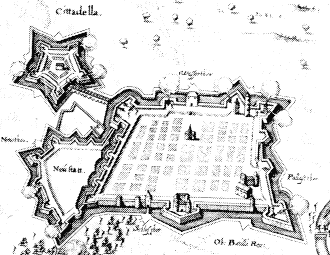New Fortifications For Old Towns
An alternative to replacing old medieval walls with the new Trace Italienne design around well-established cities and towns was to
build up and add onto what was already there,
as discussed on this page,
and/or to construct fortifications outside the community's edge,
such as citadels. This could be less expensive (but still
expensive) than replacing the old walls, and did not chew up real
estate in use by houses and businesses.
 These
could be entire fortifications in the new design, sited in such
places that for an enemy to get to the town, he would have to get
past the citadel. These citadels tended to be smaller than
"stand-alone" forts, likely because they could be provisioned and
manned from the town itself when not under siege. But they
could still have bastions and ditches. Illustrated
at the left is Turin and a citadel at its upper left. There's
even a causeway from the town to the citadel.
These
could be entire fortifications in the new design, sited in such
places that for an enemy to get to the town, he would have to get
past the citadel. These citadels tended to be smaller than
"stand-alone" forts, likely because they could be provisioned and
manned from the town itself when not under siege. But they
could still have bastions and ditches. Illustrated
at the left is Turin and a citadel at its upper left. There's
even a causeway from the town to the citadel.
Citadels were of whatever size (and whatever number) could be built in consideration of the anticipated danger. A particular need may have been too small to have been practical for the basic pentagon shape, so fewer bastions were made. Some were small enough to be thought of as sconces. Whether or not a structure was deemed a fortress or a citadel or a sconce depended on whom you asked then. An engineer's sconce may have been a citadel in the hyperbole of a civic-promoting burgher .
Seen, too, below the citadel in this picture is that partial forts were another means of strengthening towns. Note that the structure butts against walls of a larger fortification. Such were magnifications of outerworks like ravelins and hornworks. Whether or not to construct a hornwork or a larger partial fort (or a sconce versus a citadel) was a matter of weighing the cost/benefit ratio, factoring in time to completion and availability of resources (if that reads like modern corp-think, the principles are about the same now as then even though the particulars are different).
